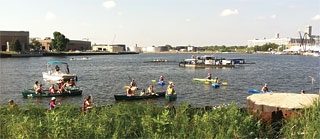Milwaukee Mayor Tom Barrett recently announced the launch of ReFreshMKE, the city’s first sustainability plan. The full, 106-page sustainability plan for 2013-2023 is now available at the project’s new website, refreshmke.com.
“Refresh MKE is a call to action around a community-endorsed set of goals and strategies that spurs economic growth while preserving our finite natural resources for our children and our grandchildren,” said Barrett. “Our climate is telling us that the old ways won’t work anymore. Refresh MKE is our roadmap on how to do more, better, but with less.”
Accompanying the plan is a $100 million financing agreement with the California-based Clean Fund that will be put toward making commercial buildings more energy efficient. Owners of downtown buildings such as the MGIC Building, BMO Harris Bank headquarters, U.S. Bank Center and City Center at 735 have expressed interest in the program.
By using PACE financing, which is run through the program Milwaukee Energy Efficiency (Me²), a partnership between the U.S. Department of Energy, the Milwaukee Office of Environmental Sustainability and Focus on Energy, property owners can pay for energy efficient upgrades as money is saved on energy bills.
If a project can be financed, said Erick Shambarger, deputy director of environmental sustainability, “Clean Fund, working with the Milwaukee Economic Development Corporation (MEDC), would provide the loan, and the loan is repaid as a municipal special charge on the property tax bill…the goal is to save more in energy in any given year than you’re paying on this municipal special charge.”
When announcing the ReFresh MKE plan, Barrett keyed on two “catalytic projects” in the announcement – a public-private inner harbor redevelopment project and the revival of the HOME GR/OWN initiative.

“HOME GR/OWN is the initiative that we had submitted to the Bloomberg Mayor’s Challenge, which deals with food sustainability and transforming foreclosed properties into urban gardens,” said Barrett.
The Milwaukee Inner Harbor Redevelopment Project is focusing on sustainable development in a 970-acre area that stretches from Erie Street Plaza on the edge of the Historic Third Ward to The Basilica of St. Josaphat, said Barrett.
“We think that there’s also potential here for more economic development, as well,” he said.

Regarding the inner harbor project, the sustainability plan says, “Given a level of investment comparable to Milwaukee’s Historic Third Ward to capitalize on the Inner Harbor’s unique assets, the area has the potential to become a vibrant urban district with employment centers and a restored neighborhood fabric built along a working, modern and progressively operational waterfront.”
Barrett added that this also includes “a job component of 22 jobs per acre, which is analogous to what we did in the (Menomonee) Valley where we tied the development there to jobs per acre.”
This sustainability initiative is the result of 18 months of planning and organizing with Barrett’s appointed “Green Team.” The leader of the “Green Team,” Matt Howard, the city’s environmental sustainability director, said the project is organized by eight issue areas: buildings, energy, food systems, human capital, land and urban ecosystems, mobility, resource recovery and water.
“We feel this is a comprehensive road map for community sustainability,” said Howard. “The mayor and I and the Green Team really feel that this provides the vision and new ideas for Milwaukee to be a center of sustainability, innovation and thought leadership in our country. I truly believe that.”
Howard said the project’s progress will be transparent to the public.
“Each chapter, including catalytic projects, has a goal and a target, and the vast majority of the targets have an associated date by which they should be completed,” he said. “We’re going to do a scorecard each year reporting progress.”
Howard also listed many “Green Team” partners in this initiative, including individuals from ASQ, Walnut Way Conservation Corp., Wisconsin Regional Training Partnership/BIG STEP, Center for Resilient Cities, the City of Milwaukee Department of Public Works, Laborers’ International Union of North America, River Revitalization Foundation, Midwest Environmental Advocates, Fix Development LLC, the Department of City Development, the UWM School of Freshwater Sciences, and the Redevelopment Authority, along with corporate partner CH2M Hill.
Howard said the initiative’s funders include the American Recovery and Reinvestment Act, U.S. Department of Energy Efficiency and Conservation Block Grant (EECBG), and The Brico Fund.
“Refresh MKE is a comprehensive effort,” said Howard. “It’s not just a planning document. It’s a call to action and it’s a path forward for creating a more sustainable city.”
The city’s first sustainability group, or “Green Team,” was an idea brought to the mayor by Julilly Kohler, and was assembled in 2004, said Barrett.
“When I formed Milwaukee’s first public-private ‘Green Team’ in 2004, I honestly never imagined the spirit of that work would continue into my third term as mayor,” he said. “The 2005 ‘Green Team’ report helped guide city policies and projects. The city of Milwaukee implemented the vast majority of their recommendations between 2005 and 2012, demonstrating our commitment to sustainability. In order to build off that important early work, I appointed a new Green Team in 2012, and charged them with developing the city’s first sustainability plan, Refresh MKE.”
Dan Shafer covers innovation and technology for BizTimes Milwaukee. Send news to him at dan.shafer@biztimes.com or follow him on Twitter @danshaferMKE.


